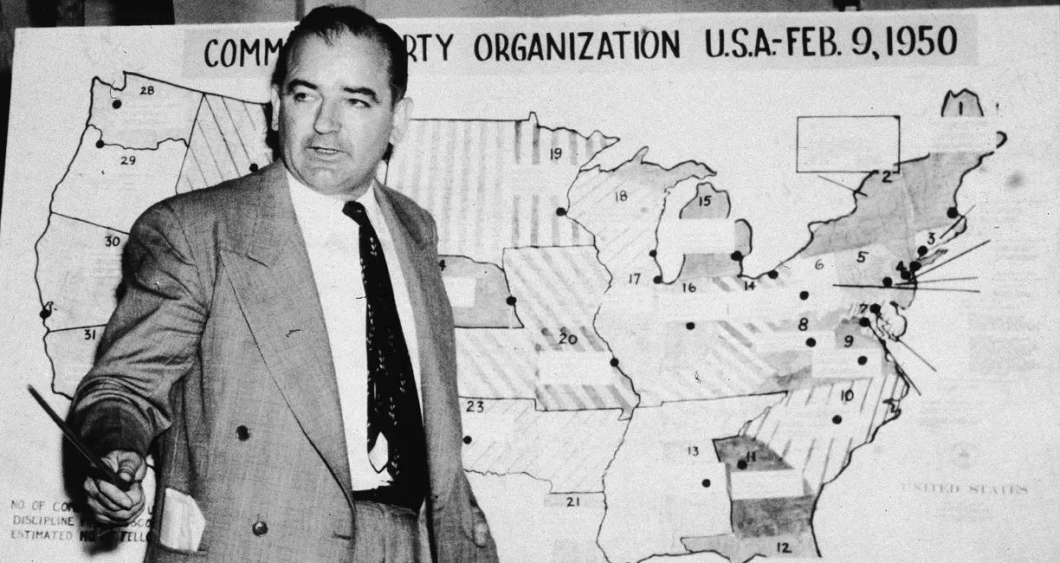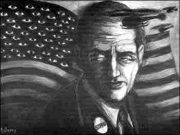Americans want to believe in the future, that getting ahead and opportunity are still fundamental to being American.
History as Partisan Cudgel
Richard Hofstadter was a prominent historian during America’s post-World War II rise. He reflected and established important tendencies in the progressive narrative of American history, so his career reveals much about America’s self-understanding and the tensions within New Deal liberalism. He won two Pulitzer Prizes, one for The Age of Reform (1956) and the other for Anti-Intellectualism in American Life (1964). Library of America is out with a volume that contains two of Hofstadter’s famed contributions to political history—the aforementioned Anti-Intellectualism and The Paranoid Style in American Politics (also 1964)—as well as sundry essays written between 1956 and 1965.
The Hofstadter of this volume writes history while keeping one eye on America’s political situation. Hofstadter votes against Barry Goldwater on every page, while surveying anti-intellectualism and America’s paranoid style. All the progressives’ men turn out to be clear-eyed, public-spirited intellectuals and reformers, while their opponents are most often proto-fascists or reactionaries unaware of the world’s complexities or the achievements of science. But his manner of smearing his opponents opened the way to a liberalism he neither foresaw nor could resist.
Born to a secular Jew married to a nominal Protestant in 1916 Buffalo, Hofstadter was a communist of sorts as an undergraduate at the University of Buffalo. He headed the Communist-affiliated National Student League. His fellow-travelling continued as he enrolled in Columbia’s graduate program for history in 1938. He quit communism before the Hitler-Stalin Pact in Summer 1939. He finished his Ph.D. in 1942, began studying Frankfurt School sociology on his first academic job at the University of Maryland, and then landed back at Columbia in 1946. Columbia was his home—and he was a court historian of liberalism during his heyday. He jet-setted to lectures all over the world, picking up prizes and honors along the way until his death in 1968.
The Library of America volume shows how the Frankfurt School influenced Hofstadter. The Frankfurters gave him categories within which to understand what he took to be the proto-fascist opposition to American liberalism. Such opposition stood in the way of an enlightened liberalism that was destined to rule as a force of light in an otherwise dark world.
The Frankfurt School and Proto-Fascism
Theodor Adorno and Max Horkheimer are the seminal thinkers of the Frankfurt School. The most important book for understanding how the Frankfurters influenced Hofstadter is The Authoritarian Personality (1950), a work Adorno co-authored. Behind this book lay a troubling question: how could a civilized country like Germany adopt Nazi ideology and rule? The answer: German civilization produced what Adorno and his colleagues called the “potentially fascistic individual.” Such people admire those who are tough, appreciate competition, dwell in the world of action, distrust science, value order and moral purity, take and obey orders, and are open to conspiracy theories. Adorno and his colleagues developed a “fascist-scale” personality test to judge how much each individual is susceptible to fascistic appeals.
Countries with market economy and a relatively conservative moral environment (e.g., suspicious of obscenity and sexual deviancy) breed fascism. America was as high on the “f-scale” as Germany, psychological studies seemed to confirm. America did not celebrate free love. It marginalized people. Its market economy demanded a discipline and even regimentation that made the country incipiently fascist. Thus the veneer of science covered the progressive trope, around since the time Sinclair Lewis implied that “it could happen here.”
Hofstadter lauds how such social science helps to identify “general psychological assumptions” that move in the “modern intellectual climate.” He clearly believed that historians could build on those insights. Two books in the Library of America volume speak directly to this. Anti-intellectualism in politics and culture, for Hofstadter, is a proto-fascist suspicion of reform reflecting a desire to re-impose a mythical past. As nostalgic anti-intellectualism is sown into the American tradition, so is America’s susceptibility to fascist dictatorship that is concerned to reimpose a bygone past. Andrew Jackson suspected progressive elites. Joe McCarthy suspected progressive intellectuals. Hitler rose to power while suspecting progressive elites and intellectuals. This, as we will see, is not a coincidence.
Much the same is true of paranoia. From the anti-Masons and Know-Nothings to the anti-communists, some Americans worry that cosmopolitans and foreign influences are eating away at American virtues. Americans are susceptible to feeling dispossessed or to fear losing their status within their own land. Paranoid partisans put forward an “apocalyptic and absolutist framework” that a conspiracy is afoot in the country. Only militant, determined action among the paranoid can put a stop to such a cunning enemy. What the Jews were for Hitler, the communists and liberals were for McCarthy. America might not have death camps (yet!) in Hofstadter’s assessment, but it was determined vigilance by clear-sighted intellectuals in our political system that has prevented them. McCarthy’s career was faded by the 1960s but Barry Goldwater was picking up McCarthy’s mantle. For Hofstadter, stopping Goldwater in 1964 was a domestic Munich—and LBJ had more backbone than Neville Chamberlain. His Paranoid has a long chapter on the fascist meaning of Goldwater, and four of the twelve occasional essays concern the Goldwater phenomenon. Preoccupation with perceived threats from the right live on in the derangement syndromes conjured by Republican presidents.
Hofstadter did not accept the Frankfurt School hook-line-and-sinker. The solution to the problem of the “potentially fascistic individual” for Adorno and crew was an embrace of liberation, a destruction of all institutions that repress human sexuality and control human passions. Only if individuals can express all of their passions, they held, can people be sure that the repression that distorts passions is safe for democracy. This would involve liberating individuals mostly from the private, bourgeois family (what they dub the authoritarian family) as a means of destroying capitalism (another system that was thought to depend on repressing desires or delaying gratification). A straight line connected the early Frankfurters to the sexual liberationists like Herbert Marcuse.
Hofstadter never went that far, but it is hard to know why. As he wrote to his brother-in-law during the 1930s, “I hate capitalism and everything that goes with it.” He saw the Vietnam War as a great calamity bespeaking the rise of a fascist movement in America. Anti-Intellectualism and Paranoid Style are peppered with criticisms of the sexually uptight and the problem of moral absolutism. Yet Hofstadter lived long enough to see and criticize the student protest movements of the late 1960s, as he did in his swan-song Commencement Address in June 1968. His respect for the genuinely clear-seeing, liberal intellectual grounded in a sound scientific method sustained his unwillingness to go as far as the Frankfurters. Liberation must be limited by a respect for rationality and inquiry. Hofstadter’s seeming unwillingness to cave to Columbia’s radicals is of a piece with his defense of New Deal rule.
The New Deal Liberal Claim to Rule
Each of Hofstadter’s books acknowledges that it is dealing with a permanent issue of politics. Anti-Intellectualism recognizes that the there is a tension between philosophy and the city. Aristophanes may have been the first anti-intellectual, for criticizing Socrates for spending his time in the clouds without worrying about the effects of his natural philosophy on the city’s gods and mores. Hofstadter acknowledges the fate of Socrates and Thomas More, two great political martyrs, at the hands of anti-intellectuals. And one reason America is beset with conspiracy theorists is that politics as a whole is beset with conspiracies—a closed, tight group who sets out to change the politics of a particular time and place. Conspiracies abound because elites are the primary movers in politics. Perhaps showing why conspiracy theorists or the paranoid are wrong in a particular case would contribute to our knowledge of politics.
For Hofstadter, however, “anti-intellectualism” and “paranoid style” arise in specifically new and dangerous ways in modernity, now that the age of enlightened administration has arrived. There no longer has to be a tension between wisdom and consent and the elite no longer poses a threat. These permanent issues in politics turn into partisan cudgels. Thus is history detached from a queen among the humanities and transformed into something more relevant to electoral and day-to-day politics.
Each book identifies a dichotomy—anti-intellectuals (e.g., the “conventional” and “inarticulate” Dwight D. Eisenhower) vs. the intellectuals (e.g., Adlai Stevenson, “a politician of uncommon mind and style” and FDR); and the paranoid (e.g. McCarthy and Goldwater) and the clear-eyed (again, Stevenson). Each of Hofstadter’s dichotomies helps justify the rule of New Deal elites. Opponents of the New Deal in particular and progressive reform in general are either paranoid or stupid, living in a mythic past of racial purity or unable to grasp the needs of the modern world, while proponents of the New Deal can handle complexity through scientifically-informed intelligent management. Let us look at how Hofstadter’s dichotomy works itself out in his two books.
Anti-Intellectualism. Hofstadter puts forth no definition of intellectual or anti-intellectual. Instead, he shows how the use of reason, differently understood, has competed with the demands of practice in American religion, politics, business and education. We know intellectuals when we see them! In politics, for Hofstadter, the United States was “founded by intellectuals” (i.e., smart, public-spirited men), though such intellectuals disappeared until the Progressive Era reformers and New Dealers arose. Anti-intellectuals like Andrew Jackson, in contrast, were hostile to “political specialization” or “trained leadership.” Anti-intellectuals used “inborn, intuitive, folkish wisdom” or “native practical sense.”
Intellectuals were internationalist and “cosmopolitan,” while anti-intellectuals connected themselves to soil and blood or at least to what they took to be the special mission of the country. Intellectuals were believers in “genteel reform” such as civil service reform or regulating monopolies or income tax or the National Recovery Act, while anti-intellectuals liked the horse and buggy. At stake in this debate, for Hofstadter, was “the place of mind in American politics,” not a conflict of two intelligent visions.
A couple of examples where intellectuals battled anti-intellectuals will reveal Hofstadter’s method and what he ignores. Civil service reform may have been needed in the 1870s and 1880s, but what was at stake in it? Call me an anti-intellectual, but the issue might be this: a national executive cannot change out all federal personnel intelligently without it soaking up all the president’s energy. Yet sparing his energy comes with a risk. Civil service reform could set up a caste within our government with an interest different from the rest of the people. For Hofstadter, in contrast, civil service reform was simply a battle between those who favored “competence, efficiency and economy in public service, open competition for jobs on the basis of merit, and security of tenure” against those who favored folk wisdom, party rotation, and witchcraft. It’s an honest debate where both sides are sincere: some like sound science; others prefer reading the entrails of chickens.
This tension between the anti-intellectual public and the experts “seemed to be disappearing” in the progressive era; after a hiatus for a generation, “the rapprochement between intellectuals and the public was restored” during the New Deal. The intellectuals including reformist presidents like Teddy Roosevelt and Woodrow Wilson and writers like Herbert Croly and John Dewey merely wanted to “humanize and moralize” great corporate power with expert administrative agencies, while anti-intellectuals invoked the good old days. Tensions between intellectuals and anti-intellectuals rose after World War I when “the public turned on the intellectuals as the prophets of false and needless reforms” while the intellectuals turned on the public as “boobs, Babbitts, and fanatics.” The same pattern emerges from the New Deal.
Against the paranoid are those who recognize complexity, who are open to change and tolerant, and who do their best to navigate through the rough waters using sound science as their guide. Many pseudo-studies confirm what Hofstadter also thought he saw: left-leaning liberals are more open to experience and tolerant. That is why there are said to be so few conservative college professors.
The idea that anti-intellectuals outside the academy or the administrative state are deplorables, clinging to God and guns, is the central trope of Anti-Intellectualism.
Paranoid Style. Anti-intellectuals naturally unite with the paranoid style. Hofstadter recognizes that the study of paranoia raises questions of honor. Politics is not so much about “who gets what, when, and how,” but about “who perceives what public issues, in what way, and why?,” he writes. For Hofstadter, these questions of perception point to the issue of status about whose ideas of justice will make its way into law and culture.
For Hofstadter, managerial liberalism is the intellectual lens through which right-thinking Americans ought to perceive public issues; therefore, those who object must have something wrong with them. They are paranoid pseudo-conservatives, who have “a chronic mental disorder characterized by systematized delusions of persecution and one’s own greatness.” Hofstadter draws this framework from Adorno. Pseudo-conservatives, for Adorno, value order and authority in times of tumult; and they see tumult coming from conspiracies that can be defeated through vigilance followed by decisive, patriotic action. Such pseudo-conservatives demand conformity. Ethnic conformity—therefore they are racists and xenophobic. Sexual conformity—therefore they are Handmaids Tale-like misogynists and homophobes.
For Hofstadter, the paranoid style rests on an “apocalyptic and absolutist framework”; projects a “vast and sinister,” perhaps international “conspiracy against a way of life”; and demands the rise of a “militant leader” to combat it. Why do they perceive public issues in this way? Fear of change. Fear of the other. A demand for conformity. The need for order. From Goldwater to Hitler in 5.2 seconds.
Against the paranoid are those who recognize complexity, who are open to change and tolerant, and who do their best to navigate through the rough waters using sound science as their guide. Many pseudo-studies confirm what Hofstadter also thought he saw: left-leaning liberals are more open to experience and tolerant. That is why there are said to be so few conservative college professors.
Broken Establishment
Each book seeks to reconcile the public to the rule of intellectuals or experts—and to minimize the political input that the paranoid, anti-intellectual public might exercise over governing intellectuals. Yet Hofstadter notes problems. As intellectuals become the establishment (as they had in the 1960s), Hofstadter worries, intellectuals will lose their critical stance toward what is; they will become the system. Then factions within the establishment will emerge—and status politics will take place within the ruling elite. Anti-intellectualism and paranoid styles could come to the establishment, but the establishment itself will not be able to see it.
When conspiracy theories and anti-intellectualism do (or rather when they did) come, the old liberals would be without a ground to stand on. Hofstadter was a party of one. Hofstadter used Adorno’s concepts to criticize the opponents of the New Deal, smelling in their anti-communism and free market economics the stench of fascism. Followers of Adorno joined the New Left because it criticized New Deal liberalism. This needle Hofstadter could not thread.
Thus the Old Liberals died or converted to a new conservativism sufficiently un-paranoid and intellectual. The New Left ascended, first spectacularly in the late 1960s and then slowly over the course of two generations. Hofstadter’s critique of America became part of the New Left’s DNA, and his moderation was easily overcome with the categories of thought he himself had used to discredit his opponents on the right.
In characterizing opponents of managerial liberalism as paranoid Hofstadter mostly makes their point. In dismissing their concerns as paranoid and anti-intellectual, he paved the way for a style of thinking that has devolved into totalitarian fantasies and enemies’ lists. A better approach would begin with concerns of citizens and then elevate them to first order issues, instead of dismissing them as the ravings of morons, lunatics, or racists. The best approach would be to see the issue of anti-intellectualism as an expression of the permanent tension between wisdom and consent and the paranoid as a genuine conflict over honor. Hofstadter was too much a partisan to notice his own blinders, and too little a philosopher to see the permanent things.



